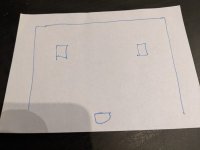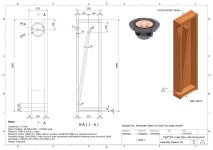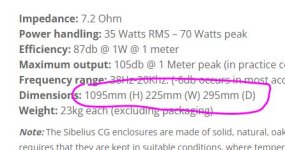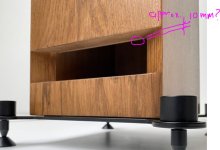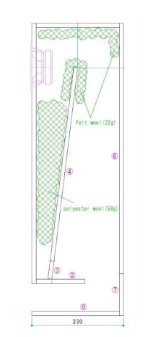As stated above, I don't think mine was a fair comparison. I didn't seriously audition the Sibelius - merely listening for a few minutes in an unfavorable environment. Prior to the frugalhorn transplant the Alpair10.3M(A)s sounded fine in mine - and I've always assumed that the Sibelius should probably have a similar presentation. The secret sauce for me is the MAOP drivers, which are everything they're cracked up to be and took the frugalhorns to a different level.
Happily for my bank balance, I can therefore remain convinced that in my room, with my kit, frugalhorns+MAOPs outperform standard Sibelius.
(Also that smallish boxes AND crossovers are best avoided whenever possible, but those are different issues.)
Happily for my bank balance, I can therefore remain convinced that in my room, with my kit, frugalhorns+MAOPs outperform standard Sibelius.
(Also that smallish boxes AND crossovers are best avoided whenever possible, but those are different issues.)
They are? I didn't realise that. 😉 The last time I checked the FH series were not standing wave generators but tapped 1/4 space & > corner horns.@davidjt Not that I checked the tuning fr on the frugalhorn, but both speakers you talk about are tqwt types and very similar and now your comment got me curious. Why do you think you experiences such a difference between them two ?
LOL ... on a more serious note. By simply changing the tapered orientation, you get a completely different performance - that stuff is fascinating. Maybe not so strange after all since most of the acoustic energy is allowed to evolve in an expanding opening right behind the driver (FH) vs expanding into a "trap" which is the case of the Sibelius.
I simply changed the tapered orientation?  😉
😉
Sibelius is a Mass Loaded single tapped horn, aka an ML-Voigt, 'V-horn' (new one on me, but as a description it's sensible), or slightly more contentiously depending on who you ask, an ML-TQWT / ML-TQWP. I don't like the latter term very much, so I usually just call cabinets of that general type ML-horns or ML-Voigts. Because it's mass loaded, i.e. has a restricted terminus it's functionally a relatively broad-band standing wave generator, but because it's restricted, it has no real horn loading as such in its functional BW. I'm not giving anything away with that: anybody can tell just from the terminus size, as a fully impedance matched horn tuned to the same frequency would have a terminus area larger than many living room / lounge walls. The FH series are [single] tapped corner horns -technically the baseline design assumption is always 1/8 space, but I design them to have decent gain & acoustic high pass performance under 1/4 space conditions. Functionally the only things the two really have in common is that they have a baseline taped horn basis, i.e. there is no low-pass filter chamber per se, the driver being tapped into the horn at a given point along its expansion, the exact location varying depending on the design.
 😉
😉Sibelius is a Mass Loaded single tapped horn, aka an ML-Voigt, 'V-horn' (new one on me, but as a description it's sensible), or slightly more contentiously depending on who you ask, an ML-TQWT / ML-TQWP. I don't like the latter term very much, so I usually just call cabinets of that general type ML-horns or ML-Voigts. Because it's mass loaded, i.e. has a restricted terminus it's functionally a relatively broad-band standing wave generator, but because it's restricted, it has no real horn loading as such in its functional BW. I'm not giving anything away with that: anybody can tell just from the terminus size, as a fully impedance matched horn tuned to the same frequency would have a terminus area larger than many living room / lounge walls. The FH series are [single] tapped corner horns -technically the baseline design assumption is always 1/8 space, but I design them to have decent gain & acoustic high pass performance under 1/4 space conditions. Functionally the only things the two really have in common is that they have a baseline taped horn basis, i.e. there is no low-pass filter chamber per se, the driver being tapped into the horn at a given point along its expansion, the exact location varying depending on the design.
Last edited:
Thanks for taking the time. Since neither loudspeakers are close by to me, I simply have to build both variants and compare. Sometimes, that is the only way forward.
I'm gonna take the time and read the official FH tread and learn as much as possible 😀
I'm gonna take the time and read the official FH tread and learn as much as possible 😀
Last edited:
but both speakers you talk about are tqwt types
Frugel-Horn Mk3 is not a ML-Voigt (aka TQWT),
dave
And now I know.. we learn something new every day and I have a whole thread to consume [Frugel-Horn XL]
Ofc there's been development, but I'm new here and I'd like to start from the beginning, that is how one truly grasp a new topic - learn the basics and more advanced stuff will make more sense 😉
From memory, I was told that the FHs were considered 'keepers', but failed the WAF test: hence the Sibelius. In retrospect, ignorance led me to draw too many conclusions from that statement. I enjoy melting solder, but ever since my craft master at school described my efforts at woodwork as GBH I've steered clear of cabinet making. (The current tariff for gbh is four years to life, depending on proof of intent.) So I've never studied the finer points of speaker design. I'll refrain from commenting in future.
As for those favorite MAOPs of mine, I think it's the attack and decay that produces the magic but that too may be an over-simplification.
As for those favorite MAOPs of mine, I think it's the attack and decay that produces the magic but that too may be an over-simplification.
MAOP 10.2 strength is probably its homogeneity and its straight frequency response. I can't think of anything to complain about in terms of the sound.
So, no baffle step............
Is there so much coming out of the port/horn that it is un-needed, similar to a rear loaded horn ?
I am curious to see on a graph, what and how much off the 20-20khz is coming out of the opening.......
Is there so much coming out of the port/horn that it is un-needed, similar to a rear loaded horn ?
I am curious to see on a graph, what and how much off the 20-20khz is coming out of the opening.......
You'll need to buy and measure a pair then.
A point to keep in mind with any loudspeaker though (commercial, DIY or otherwise) is that EQ assumptions for step-loss are usually based on the assumption of a flat IB driver response, which isn't always the case.
A point to keep in mind with any loudspeaker though (commercial, DIY or otherwise) is that EQ assumptions for step-loss are usually based on the assumption of a flat IB driver response, which isn't always the case.
I had to look up the 1/4 and 1/8 space terms.The FH series are [single] tapped corner horns -technically the baseline design assumption is always 1/8 space, but I design them to have decent gain & acoustic high pass performance under 1/4 space conditions.
So... the "corner" you're thinking about in 1/4 space is the corner between the rear wall and the floor? And for 1/8 space the side walls would be closer than farther away? Not like a Klipschorn is a corner horn that has an intimate relationship with a two-walls-and-a-floor corner.
I've seen it observed that the FHXL needs careful placement. How much tweaking and/or fine tuning should one expect to do? Maybe consider renovating the rear wall to achieve the corner "space" that works best (rather than toeing in?
On the Sibelius - Pensil - FH comparisons... wouldn't the driver character dominate in principle and practice? That we basically have Mark Audio 10.3s (say) in common wouldn't there be a lot of commonality in sound?
For the comparable enclosures, if the tapered section and tap location was similar for each enclosure, wouldn't the upper registers be pretty similar too (with the bass differing as the rest of the enclosure varies between designs?
I'm just trying to wrap my head around the order of effects of all the ingredients.
Attachments
Hard to say.
I bet the sibelius is better due to a number of small improvements/tweaks adding up to a definite improvement compared to what a 1 shot build would be.
I bet the sibelius is better due to a number of small improvements/tweaks adding up to a definite improvement compared to what a 1 shot build would be.
@norman bates
From what I've sen of Scott and Dave, they've been actively prosecuting progressive refinement and investigation for years.
And the means of personal tweaking are much more available if one builds 'em with understanding.
From what I've sen of Scott and Dave, they've been actively prosecuting progressive refinement and investigation for years.
And the means of personal tweaking are much more available if one builds 'em with understanding.
I think this should be the correct cabinet drawing for the Sibelius CG.
Edit: the location from top of cabinet to center of driver exactly scaled and measured from my computer screen, exactly 120mm.
Also done with the bass opening on the bottom, exactly 2x 50mm.
Edit: the location from top of cabinet to center of driver exactly scaled and measured from my computer screen, exactly 120mm.
Also done with the bass opening on the bottom, exactly 2x 50mm.
Attachments
Last edited:
- Home
- Loudspeakers
- Full Range
- Pearl Acoustic Sibelius

